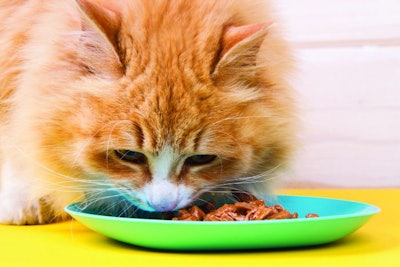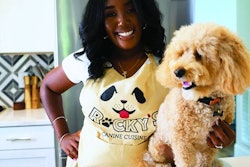
Dry pet food accounts for 75% of global volumes, but alternative formats, functionality claims and sustainability are driving trends in the premium pet food market.
That is according to Mark Strobel, senior research manager with Euromonitor International, who spoke May 1 during Petfood Essentials in Kansas City, Missouri, USA.
Dry pet food “is convenient, it's shelf stable, it's got long shelf life and it is nutritious. I know some people who have been feeding their pets dry kibble for decades,” Strobel said. “And it is cheaper than wet foods, so it is this good balance between affordability and quality.”
And, despite efforts by many pet food brands to display imagery on their packaging that differentiates their product from the competition, such as wilderness scenes, wild animals such as wolves and bobcats, raw meats, and fresh ingredients, there is a “kibble disconnect” when the product inside these packages looks the same as any other similar product on the market, Strobel said.
“It's still kind of the same dry kibble. It almost feels like what's inside of the bag was not what that packaging is promising,” he said. “So, there's a lot of opportunity in these new processing methods and these new formats of food that ultimately have the pet food look more like actual food and food that I might want to eat or even feed to my family.”
Newer processing methods
These newer processing methods include raw, fresh cooked and “new wet” products, which include stews, broths, pates and purees. All three of these formats have seen very strong growth in recent years, Strobel said, adding that ecommerce has contributed to that growth.
In 2019, ecommerce accounted for 17% of global pet care sales, but grew to 23% in 2020 and continues to grow. Euromonitor estimates that more than one-third of global pet care sales in 2028 will be through ecommerce.
A survey from January and February 2023 found that 30% of pet owners in the U.S. feed their pets wet food almost daily, and 12% fed their pets raw food almost daily. These trends, coupled with greater market penetration, Strobel said, are helping to drive premium wet dog and cat food to be, by far, the fastest-growing segment in pet food.
The pet humanization trend has also contributed to format diversification, such as snacks, beverages and baked goods for pets. Euromonitor’s Lifestyle Survey found 71% of pet owners globally consider their pets to be family members, and the proportion is increasing in emerging markets.
Functionality claims
As pet owners increasingly see pets as members of their families, they are also looking for ways to serve their specific health needs through food.
“There's taurine for cardiovascular health, there's fiber and probiotics for gut health, vitamins and selenium for immune health. So, again, just very much highlighting those functional ingredients and being able to find those functional benefits,” Strobel said.
Natural and organic claims are also key, following on human food trends.
Also gaining traction is “free from” claims; the top four label claims on pet food packages are grain free, no artificial preservatives, no artificial colors and no artificial flavors, and these are also increasing.
When shopping online, “pet owners can very easily just select for these free-from claims, making it easier and easier to filter and find products that have those claims,” he said.
Sustainability concerns
Pet owners are increasingly concerned about the sustainability of pet food packaging, ingredients and sourcing.
“It's pretty well established at this point that sustainability is a pretty big deal in pet foods,” Strobel said.
Innovation has allowed for the development of packaging that is fully recyclable or made of recycled materials. Innovation has also contributed to the growth and inclusion of alternative proteins, such as insects and plant-based ingredients, in pet food.
There is also a growing interest in “responsible” sourcing of ingredients and “humanely raised” animal protein sources, Stobel said.
















